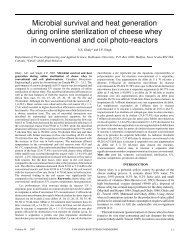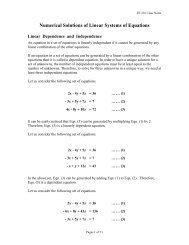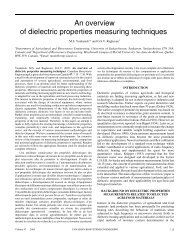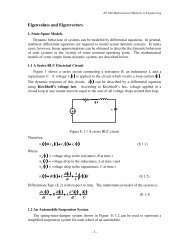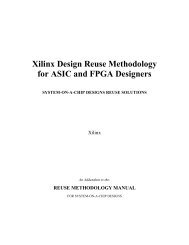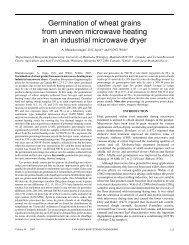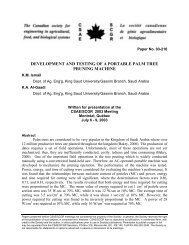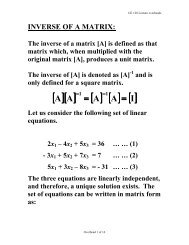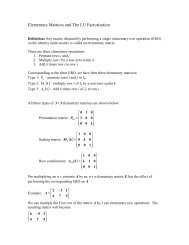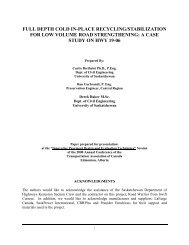Cold-In-Place Recycling using Asphalt Emulsion for Stabilization of ...
Cold-In-Place Recycling using Asphalt Emulsion for Stabilization of ...
Cold-In-Place Recycling using Asphalt Emulsion for Stabilization of ...
Create successful ePaper yourself
Turn your PDF publications into a flip-book with our unique Google optimized e-Paper software.
158 USING ASPHALT EMULSION TO STABILIZE LOW VOLUME ROADS<br />
5 LABORATORY ANALYSIS OF ASPHALT EMULSION<br />
The characteristics <strong>of</strong> each asphalt emulsion used in this study are summarized in Table 1.<br />
Table 1 <strong>Asphalt</strong> <strong>Emulsion</strong> Characteristics<br />
CHARACTERISTICS HF-150S* SS-1C**<br />
Viscosity @ 50 deg C, S.F.S. (ASTM D 244) 65 -------<br />
Viscosity @ 25 deg C, S.F.S. (ASTM D 244) ------- 23<br />
Penetration <strong>of</strong> residue@ 25 deg C<br />
(100gm, 5 sec), dmm (ASTM D 5) 182 200<br />
Residue by distillation, % by weight (ASTM D 244) 61.1 59.4<br />
Total distillate, % by weight (ASTM D 244) 38.7 40.5<br />
Oil portion <strong>of</strong> distillate, % by weight. (ASTM D 244) 1.7 0.5<br />
* HF-150s is a high float medium setting asphalt emulsion designed <strong>for</strong> seal coating<br />
**SS-1c is a slow setting cationic asphalt emulsion.<br />
As can be seen in Table 1, the properties <strong>of</strong> HF-150s and SS-1c are similar. The primary<br />
difference between HF-150s and SS-1c is that HF-150s is a medium set emulsion where as SS-1c is a<br />
slow setting emulsion. The <strong>Asphalt</strong> <strong>In</strong>stitute’s Manual Series -19 (MS-19) [7] states that a medium set<br />
emulsion is normally used with aggregates that do not have an excessive amount <strong>of</strong> fines. Conversely,<br />
slow setting emulsions are normally used with aggregates that have a significant amount <strong>of</strong> fines [7]. HF-<br />
150s emulsifier also imparts a gel structure to the asphalt residue. This gel structure and chemical charge<br />
results in increased film thickness, which prevents the asphalt cement from bleeding and draining down<br />
<strong>of</strong>f the aggregates. SS-1 is slow setting because <strong>of</strong> the higher amount <strong>of</strong> emulsifier present in the<br />
emulsion, which prevents it from breaking as soon as it becomes in contact with the aggregate.<br />
6 LABORATORY MIX ANALYSIS<br />
The <strong>Asphalt</strong> <strong>In</strong>stitute MS-19 [7] mix analysis procedure was used to determine the target design<br />
asphalt emulsion contents <strong>for</strong> each mix. MS-19 contained two <strong>for</strong>mulas based on the percentage <strong>of</strong><br />
aggregate passing the 4.75 mm (No. 4) sieve. (Is there a reason why part <strong>of</strong> Equation 1 is italicized)<br />
Base Mix Percent <strong>Emulsion</strong><br />
=<br />
Surface Mix Percent <strong>Emulsion</strong> =<br />
[( 0.06×<br />
B) + ( 0.01×<br />
C)<br />
] × 100<br />
A<br />
[( 0.07 × B) + ( 0.03 × C)<br />
]<br />
A<br />
× 100<br />
(1)<br />
(2)<br />
Where:<br />
Percent <strong>Emulsion</strong> = estimated initial percent asphalt emulsion by dry weight <strong>of</strong> aggregate<br />
A = percent residue <strong>of</strong> emulsion by distillation<br />
B = Percent <strong>of</strong> dry aggregate passing 4.75mm (No. 4) sieve<br />
C = Percent <strong>of</strong> dry aggregate retained on 4.75mm (No. 4) sieve



